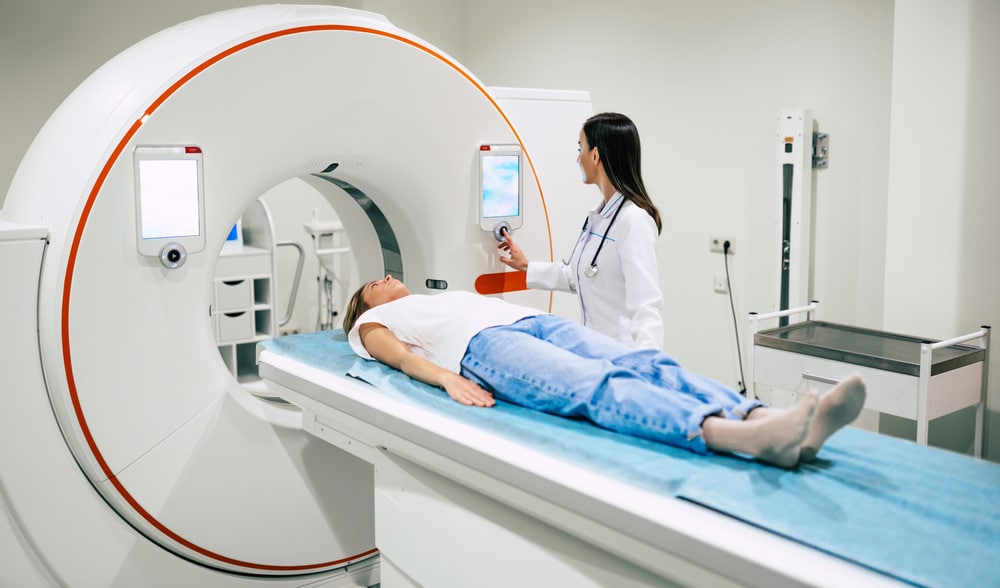What Is A CT Scan?
A CT (Computed Tomography) scan is a medical imaging procedure that uses x-rays and digital computer technology to create detailed 2- or 3D images of the body. Unlike other forms of medical imaging, the CT scan can make an image of every type of body structure at once, including bone, blood vessels and soft tissue. These images allow medical professionals to view the body’s internal structures in detail, thereby helping them to diagnose conditions, monitor ongoing treatment or plan surgeries.

How CT Scans Work
The Basic Principle
The CT scanner consists of a large gantry with a circular hole. Inside the gantry is a rotating ring that carries the X-ray source and electronic X-ray detectors. An attached table slides the patient in and out of the ‘doughnut’.
Unlike a traditional X-ray, which uses a single radiation beam, a CT scanner emits a series of narrow beams as the scanner and the patient move relative to each other. Multiple X-ray projections are taken in thin cross-sections along the person’s body (imagine a loaf of sliced bread). The detectors collect the X-ray information from each cross-section and send them to a special computer that combines them into an image.
This image is far more detailed and comprehensive than a standard X-ray image, making it a valuable diagnostic tool.
Preparation for a CT Scan
Preparation for a CT scan varies based on the type of scan. In some instances, patients may be asked to refrain from eating or drinking for several hours before the procedure. This is especially important for an abdominal scan, as it ensures the stomach and intestines are empty and won’t obscure the images.
Many scans may require the patient to ingest or be injected with a contrast material, containing iodine. This dye helps to enhance the visual contrast in the final images, allowing for better visibility of blood vessels, tissues and specific organs. More information can be ascertained when we use contrast dye and some diagnoses cannot be made without it. If you cannot have contrast dye, please discuss with your GP as they may be able to refer you for another scan, such as ultrasound or MRI.
Please wear loose comfortable clothing without metal zips or clasps if possible. You might be asked to remove metallic items like jewellery, dentures, underwire bras, glasses and hearing aids.
Procedure of a CT Scan
During a CT scan, the patient lies on a specially designed table that slowly passes through a large, doughnut-shaped scanner. The radiographer controls the scan from a separate room. The scan itself is painless and takes anywhere from 3 to 30 minutes, depending on the complexity of the scan and the part of the body being examined. You are asked to lie as still as possible, so the images are clear and not blurry and may be asked to follow simple breathing instructions.
After the scan, the images are reviewed and reported by a Radiologist (Medical Imaging Specialist) and the report is sent back to your GP or referring doctor for follow up.
Uses of CT Scans
CT scans are crucial in modern healthcare and are used for a multitude of reasons:
- Diagnostics: CT scans help diagnose various conditions such as muscle and bone disorders, like tumours and fractures. They can also help identify the location of infections, blood clots or internal injuries.
- Cancer Treatment Planning: For patients with cancer, CT scans can assist doctors in planning radiotherapy or surgery by providing them with detailed images of the tumour and surrounding tissues.
- Guiding Procedures: CT scans are often used to guide biopsies, radiotherapy treatments or other minimally invasive procedures. They provide real-time images that help doctors perform these procedures with high precision.
Book Your CT Scan Today
Understanding the importance and benefits of a CT scan can alleviate some of the anxieties you might have about the procedure. InFocus Radiology is committed to providing superior medical imaging services and patient care. If you need a CT scan or have any concerns about the procedure, please don’t hesitate to get in touch.
